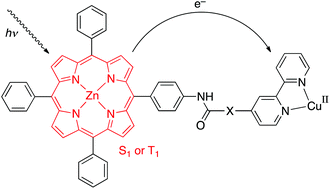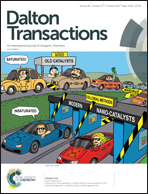Structure dependence of intramolecular electron transfer reactions of simple dyads of a zinc(ii) porphyrin complex bearing a peripheral bipyridine moiety†
Abstract
New dyad systems based on a zinc(II) porphyrin complex and a 2,2′-bipyridine moiety linked by amide bridges having various bridging groups were synthesized. The photochemical behavior was investigated using fluorescence spectroscopy and a time-resolved absorption technique. The singlet excited state of the porphyrin complex was found to be partially quenched by Cu2+ in methanol, and a photoinduced electron transfer from the excited state of the porphyrin moiety to the Cu(II)-bipyridine moiety was observed using a transient absorption technique. The relatively long lifetime of the charge-separated state was ascribed to the slow electron-transfer reaction of the Cu(II)/Cu(I) couple bound to the bipyridine moiety. The lifetime of the charge-separated state of dyads becomes longer with the increase of the distance between the porphyrin and bipyridine moieties, and these findings are discussed using an empirical formula for the relationship between the reactivity and molecular structure of dyads.



 Please wait while we load your content...
Please wait while we load your content...